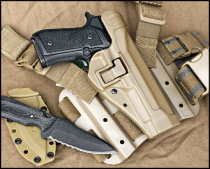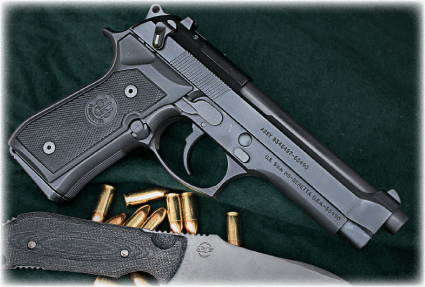A little more than two decades ago the United States military, and by that I mean the actual men and women serving in it, underwent a big change in their lives with the adoption of a new service pistol. Not only did we change caliber (a subject that is still open for debate), we adopted a completely different operating system with a double-action/single-action (DA/SA) design.
 I was a young US Marine when this changeover took place and I still remember the noise that went on in the ranks and in the firearms world in general. Gallons of ink and reams of paper were sacrificed during the debate over .45ACP versus 9mm, and the M1911A1 versus the M9. Before we move one sentence further into this review let me make it clear, I’m not going to re-fight that war.
I was a young US Marine when this changeover took place and I still remember the noise that went on in the ranks and in the firearms world in general. Gallons of ink and reams of paper were sacrificed during the debate over .45ACP versus 9mm, and the M1911A1 versus the M9. Before we move one sentence further into this review let me make it clear, I’m not going to re-fight that war.
So what is the point; why revisit the Beretta M9? Because, like it or not, at the moment there are literally tens of thousands of M9 pistols in the hands of our troops around the globe. All the editorials, reviews, or carefully crafted letters in the world aren’t going to change the fact that as these words are put to paper, the predominant sidearm of the US Military is the M9 Beretta pistol.
Advertisement — Continue Reading Below
I carried the M9 for a few years during my tour of duty and I will be the first to admit that after I left the Corps I did not carry one again for many years. Only a few months out of the Marines, I entered the police academy and during my career as a cop I carried a number of sidearms, but not the M9 or its civilian counterpart the Beretta 92.
Last year I had cause to reconsider the M9 service pistol. As a member of a Small Arms and Tactics training team, one of my jobs is to train US troops with the M9. For the first time in more than a decade I had to closely examine not only the characteristics of the pistol, but how to best operate the gun in close quarter combat.
To date I have worked with hundreds of servicemen and women, and have run across the same arguments, issues and excuses that I heard 20 years ago. The first thing shooters will do after they perform poorly on the range is to blame their equipment. Experience had taught me that, only on the rarest occasion is the equipment at fault. “Operator error” is by and large the number one reason for failure.
Advertisement — Continue Reading Below
I remember one admonition from our senior firearms instructor when I was a police academy cadet. A young officer complained that she couldn’t hit the target because there was something wrong with her pistol. The instructor took the pistol and with a single hand held it upside down. After putting a full magazine into the center of the target he handed the pistol back to the shooter and advised, “There’s nothing wrong with this gun.” The implication was obvious. It’s not the gun, it’s you.
Check out these 10 Tips to Improve Your Shooting at the Range!
As a small arms instructor I have put literally thousands of rounds of ammunition through the M9 service pistol during the last year. While I hate to give the bottom line up front, the fact is that these guns are tough and reliable. They consume magazine after magazine of hot M882 military ball ammo and keep coming back for more.
Advertisement — Continue Reading Below
In my own little corner of the world, we put shooters through much more than the standard pistol qualification course. Our students shoot hundreds of rounds on paper and steel silhouettes each week. They must shoot single- and weak-handed, perform rapid reloading drills and fire from awkward positions. In a nutshell, these pistols are run hard.
Gun Details
The current Beretta M9 service pistol is definitely a full-sized handgun. Many have criticized the choice of a DA/SA action. This criticism aside, the fact remains that it was this “first shot double-action” feature that allowed the “big military” to allow its men and women to do something they were prohibited from doing up until its adoption: carry a pistol with a round chambered and the safety on.
What many people fail to realize is that the standard practice before the M9 was to carry the M1911A1 pistol with the hammer down on an empty chamber and magazine inserted. It was not until the introduction of the M9 with its DA trigger and active decocking mechanism that the “powers that be” allowed the troops to walk around with “loaded” pistols.
Advertisement — Continue Reading Below
Considering specifics, the M9 Beretta service pistol has a 4.9-inch barrel with an overall length of 8.5 inches. This duty gun holds 15 plus 1 rounds of 9mm. The pistol is finished in Beretta’s Bruniton matte black, non-reflective coating. Sights are fixed, but the rear is drift adjustable. As mentioned, the pistol operates with a DA/SA trigger mechanism and the decocker/safety is mounted on the slide.
From a technical standpoint the M9 has short recoil, delayed locking block system as opposed to a straight blowback. In addition to the manual safety lever, the pistol includes a passive firing pin block. When a round is chambered, the extractor protrudes and acts as a loaded chamber indicator.
Training
Another change took place with the introduction of the new pistol. Rather than merely conducting slow-fire, marksmanship training with their handguns, the US military started training with their pistols in the same manner as their rifles. When I first entered the service, the only live-fire training we did was to fire our .45 pistols slowly at paper bull’s-eye targets. When we adopted the M9 we actually began shooting plastic silhouette targets. Drawing from the holster became a part of the qualification process, as opposed to the old .45 ranges where we never drew from the holster with live rounds in place.
Advertisement — Continue Reading Below
Today’s training is light years ahead of what it once was. We conduct shoot from cover drills, movement drills, and even transition training where shooters rapidly transition from a long gun to their secondary weapon, the M9.
During my own range time I worked with a number of commercially manufactured loads from CorBon, Remington, and Winchester. Over a period of two to three weeks I would hit the range several times. In addition to slow-fire and chronographing, I ran numerous drills from the holster. My holster of choice for this project was the BlackHawk SERPA drop leg rig. Over the last few years I have found the SERPA drop leg holster to be fast, secure, and reliable.
To add some realism to my training I invited a training partner along. Tactical Ted accompanied me to the range for this project. Tactical Ted is a three-dimensional plastic target available from Law Enforcement Targets, Inc. I dressed Ted in an old shirt and he was ready for training.
Advertisement — Continue Reading Below
Final Notes
Many years ago a shooting instructor of mine advised the class to “run what you brung.” He meant that rather than complain about what you wish you had or what you would rather have, get busy and train with what you’ve got.
When it comes to the M9 pistol, rather than focusing on what might have been or might be in the future, you need to focus on the tool at hand. That tool is the 9mm Beretta pistol. As an instructor it’s my job to help students focus not on “what ifs” but on the here and now.
Beretta’s M9 can be learned and operated by any sized shooter. Before I sat down to complete the final edit on this piece I witnessed a young lady with small hands and a slight frame outshoot an older man with larger hands.
Advertisement — Continue Reading Below
It wasn’t their physical size that mattered most, but their mental dedication. The young lady worked hard and dedicated herself to learning how to operate and shoot the M9 pistol. That was the true deciding factor. Until next time, train as you want to fight and fight to win.
























